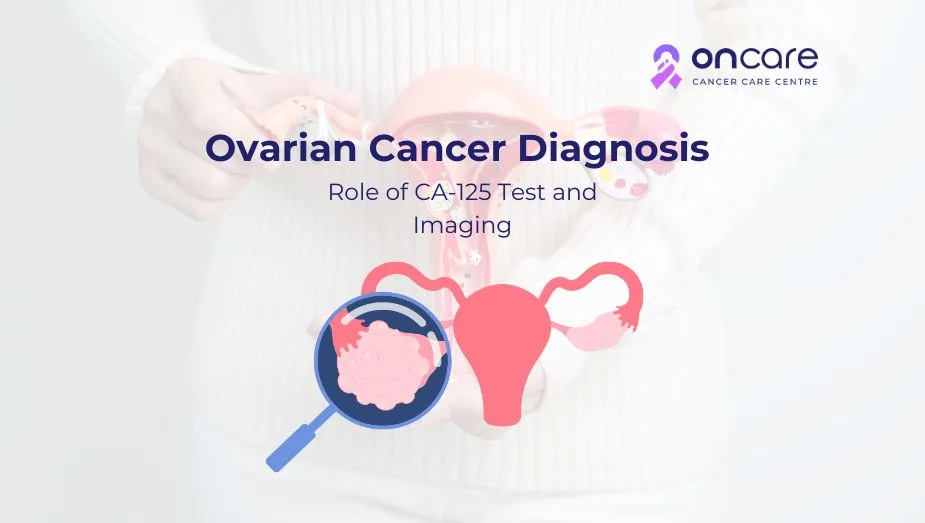Table of Contents
Ovarian Cancer Diagnosis: Role of CA-125 Test and Imaging

When it comes to detecting ovarian cancer early in women, a timely and accurate diagnosis can make a huge difference. This type of cancer often develops silently, with symptoms appearing only in the advanced stages. Studies suggest that these CA-125 tests are crucial to rely on for ovarian cancer diagnosis.
In this article, we’ll explore how these tools play a role in diagnosing cancer with the help of various imaging techniques.
What is ovarian cancer?
Ovarian cancer, also known as epithelial cancer, develops when abnormal cells in the ovaries or fallopian tubes start to grow and become out of control. The cancerous cells start to multiply quickly, and they invade and start to destroy healthy body tissues in the ovaries.
Ovaries are a part of female reproductive organs. These two round, walnut-sized organs make eggs during the reproductive years. An epithelial cancer treatment usually involves surgery and chemotherapy.
What is the CA-125 Test?
The CA-125 test is a blood test that helps to measure the amount of the protein called cancer antigen 125 in the blood. This protein is commonly called cancer antigen 125, or CA125. In some cases, these tests are often used to diagnose early signs of cancer in women with a high-risk of the disease.
Many studies claim that this test isn’t accurate enough to use for ovarian cancer screening in general. There are many conditions that can influence the level of this protein in the body.
Key characteristics of CA-125 Tests
An increased level of CA-125 proteins often shows epithelial ovarian cancer, which is the common type of cancer found in women. Studies have suggested that normal CA-125 levels are usually below 35 units/mL.
These levels often arise due to several non-cancerous cases such as endometriosis, fibroids, or menstruation.
Benefits of CA-125 Tests
There are some advantages of performing these CA-125 tests. It may include:
- Early diagnosis of epithelial cancer in a high-risk group of people, for example, women with specific genetic mutations like BRCA1 and BRCA2
- Performing these tests is highly effective in monitoring the cancer treatment effectiveness.
- These tests are effective in understanding the presence of pelvic masses, specifically in postmenopausal women, combined with other imaging and testing methods.
- These tests are useful in monitoring the cancer treatment progress.
- These types of tests are useful in detecting cancer recurrence after the completion of treatments.
- Doctors usually suggest performing these tests to investigate the chance of developing cancer, particularly in high-risk groups.
Limitations of CA-125 tests
However, there are some limitations and disadvantages of these tests. It may include:
- These tests can usually show false positive results, for example, an increased level of proteins can happen in non-cancerous conditions such as menstruation, endometriasis, uterine fibroids, pelvic inflammatory disease and several infections.
- These tests can also show some false negatives, even women who have developed ovarian cancers might also show normal levels of proteins.
- These tests are not the primary standalone diagnostic tests for ovarian cancers.
- CA-125 tests are not specific to detect these types of cancer.
- These tests are less reliable in early-stage detection; some levels may remain normal.
- These types of tests cannot be used alone for a definitive diagnosis.
What are the other imaging tests used in Ovarian Cancer Diagnosis
There are some commonly used imaging tests used in cancer diagnosis in the ovaries, these may include:
Transvaginal ultrasound
A transvaginal ultrasound is an imaging test that helps the health care team to analyze more about the pelvic cavity and the reproductive organs in the body. Performing transvaginal ultrasound can show the abnormal structures or growths in the pelvic area that might indicate the presence of cancer or other conditions in the ovaries.
CT scan
A CT scan is mostly used by doctors to locate the presence of a tumor before the surgery. The CT scan is often used to view large tumors and small ovarian tumors, which mostly don’t appear in the imaging tests. Performing a CT scan may usually help to identify the tumor size or reveal whether the cancer has spread to other organs, including the bladder, kidneys, or lymph nodes.
MRIs
An MRI is often used in combination with other tests as part of the diagnostic evaluation process. An MRI has greater soft tissue contrast when compared to a CT scan, which makes it useful in detecting tumors or any type of recurrence in other areas of the body.
PET/CT Scan
The medical procedure is often used to help diagnose ovarian, fallopian, and peritoneal cancer in women. This type of scan is mostly used to analyze mainly the tumor’s ability to identify the use of glucose, which is a type of sugar. These tests can identify faster-growing cells, which use more sugars, which often helps them show up brighter on a PET/CT scan. It often indicates the presence of cancer before it gets detected by other means.
How to combine CA-125 tests and imaging tests for accurate diagnosis?
Many studies claim that combining CA-125 or imaging testing alone won’t confirm cancer in the ovaries. Using both of these tests can significantly improve the accuracy of ovarian cancer diagnosis.
Who should get screened?
The routine screening for ovarian cancer in an average-risk woman is not highly recommended. Meanwhile, high-risk groups include women who have a family history of cancer or those with BRCA gene mutations. It might include regular CA-125 testing and ultrasounds under an oncologist's guidance.
Consult Today
A diagnosis of ovarian cancer requires a step-by-step approach while incorporating the CA-125 test, and imaging plays a major role in the treatments. It offers a chance to recognize cancer and gives treatment effectiveness.
At Oncare, we offer quality cancer treatments, including cancer surgeries, at affordable price ranges with an experienced cancer specialist consultation.
If you or any loved ones of yours are diagnosed with cancer, then visit Oncare Cancer Center and book an appointment with our cancer specialists today. Don’t wait any longer; get an estimated cost of your cancer treatments today.
Frequently Asked Questions
There are some risk factors which cause ovarian cancer. Including:
- Being over the age of 60
- Obesity
- A family history of cancer
- Never being pregnant
- Endometriasis
Ovarian cancer symptoms may include:
- Pelvic or abdominal pain
- Discomfort or bloating
- Changes in your eating habits
- Feeling full while eating less foods
- Vaginal discharge
- Abnormal bleeding
- Experiencing bowel changes
- Diarrhea or constipation
- Increase in the size of abdomen
- Frequent urination
There are different types of treatments used for ovarian cancer.
These may include:
- Surgery
- Chemotherapy
- Targeted therapy
- Hormone therapy
- Radiation therapy
Studies suggest that the overall survival rate of ovarian cancer is 49%. It means that approximately 49% of people diagnosed with ovarian cancer are alive five years after diagnosis.

